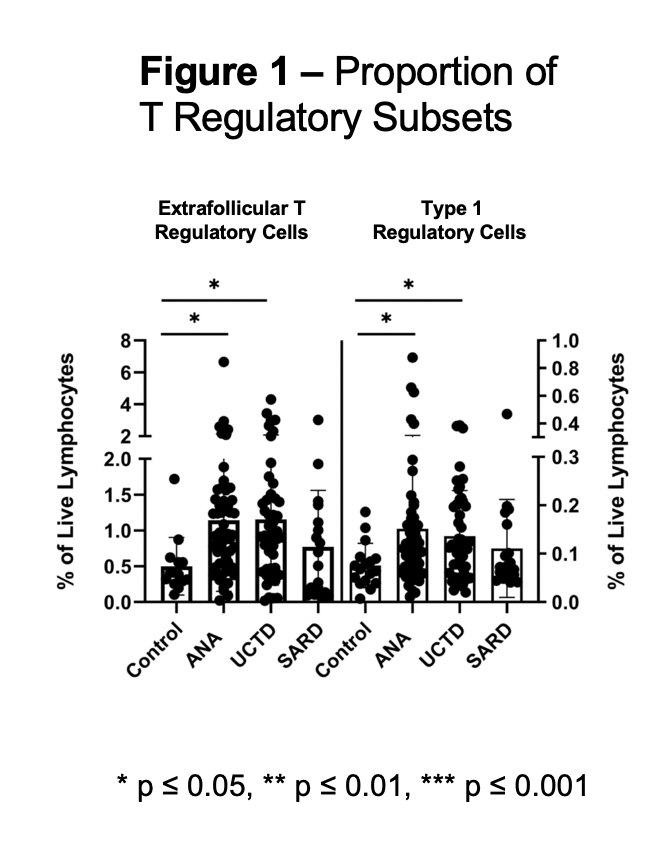Session Information
Date: Sunday, November 8, 2020
Title: T Cell Biology & Targets in Autoimmune & Inflammatory Disease Poster
Session Type: Poster Session C
Session Time: 9:00AM-11:00AM
Background/Purpose: The anti-nuclear antibody (ANA)-associated systemic autoimmune rheumatic diseases (SARDs) are characterized by a prolonged preclinical phase in which ANAs are produced in the absence of symptoms. ANAs are also seen in healthy, non-symptomatic individuals (ANA+NS), the majority of whom will not progress to SARD. Currently, the immunologic features that discriminate progressors from non-progressors are incompletely understood. Previous work has suggested that T regulatory (Treg) cell function may be disturbed in SARD. To determine whether alterations in these cell populations could contribute to SARD progression we investigated the balance between regulatory and inflammatory T cells in patient populations representative of the various stages in SARD development.
Methods: ANA+ (IF ≥ 1:160) participants were recruited through the clinic and classified as ANA+NS (n = 61), ANA+ with ≥ 1 SARD classification criteria but lacking a SARD diagnosis (UCTD, n=54) or early SARD (SLE, n=10, SS, n=7, SSc, n=5, classified according to the 1997 ACR criteria, 2013 ACR-EULAR criteria, and the 2016 ACR-EULAR criteria, respectively). All SARD patients were within 2 years of diagnosis and not taking DMARDs (hydroxychloroquine allowed) or prednisone. ANA– healthy controls (HC, n= 21) were recruited from clinical and laboratory staff. Peripheral blood mononuclear cells were isolated and stained with fluorochrome-labeled antibodies to identify immune cell populations via flow cytometry. Plasma aliquots retrieved from the same patients were used to measure TGF-ß1 levels (pg/ml) through ELISA. Statistical comparisons were made using the Kruskal-Wallis test.
Results: ANA+NS and UCTD patients had significant increases in the proportion of extrafollicular Tregs (CD3+CD4+CXCR5–PD1hiFOXP3+HELIOS+) and Type 1 (CD3+CD4+CD45RA–LAG3+) regulatory (Tr1) cells, relative to ANA–HC, whereas the levels of these cells were similar to ANA–HC in SARD patients (Figure 1). The same trends were observed for TGF-ß1 levels (Figure 2). In ANA+NS individuals there was a moderate correlation between TGF-ß1 levels and the proportion of Tr1 cells (r=0.43, p=0.009), a population that has been previously shown to secrete this regulatory cytokine. To examine inflammatory T cell subsets, CD3+CD4+CD45RA–PD1hi activated memory T peripheral (CXCR5–, Tph) and follicular (CXCR5+, Tfh) helper cells were gated and the proportion of Th1 (CXCR3+CCR6–), Th2 (CXCR3–CCR6–) and Th17 (CXCR3–CCR6+) cells in each subset were determined. As shown in Figure 3, increased proportions of Tph2 cells were seen in all ANA+ patient subsets as compared to ANA–HC but were most pronounced for SARD patients (Figure 3). Although similar trends were seen for Tph17 cells, the increase was only significant in SARD patients. The same but less significant trends were seen for Tfh cells (data not shown).
Conclusion: Our findings suggest that expanded proportions of extrafollicular Treg and Tr1 cells may act to regulate the autoimmune response in asymptomatic ANA+ individuals and that in SARD patients this becomes attenuated resulting in an imbalance between regulatory and inflammatory T cell subsets which promotes disease development.
To cite this abstract in AMA style:
Vanlieshout E, Gupta R, Bonilla D, Kim M, Johnson S, Silverman E, Hiraki L, Ahmad Z, Touma Z, Bookman A, Wither J. An Imbalance Between Regulatory and Inflammatory T Cell Subsets Distinguishes Systemic Autoimmune Rheumatic Disease Patients from Asymptomatic ANA+ Individuals [abstract]. Arthritis Rheumatol. 2020; 72 (suppl 10). https://acrabstracts.org/abstract/an-imbalance-between-regulatory-and-inflammatory-t-cell-subsets-distinguishes-systemic-autoimmune-rheumatic-disease-patients-from-asymptomatic-ana-individuals/. Accessed .« Back to ACR Convergence 2020
ACR Meeting Abstracts - https://acrabstracts.org/abstract/an-imbalance-between-regulatory-and-inflammatory-t-cell-subsets-distinguishes-systemic-autoimmune-rheumatic-disease-patients-from-asymptomatic-ana-individuals/



